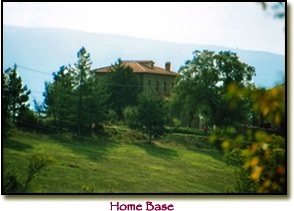HSABC Intro to Archaeology in Assisi
HSABC 2024 Orientation: An Intro to Archeology
When: August 4th – August 18th
Where we stay: our home base is a turn of the century 3-story stone schoolhouse in the hills outside Assisi with views of plum trees, fields, kittens, dogs and mountains. HS is in the midst of the Monte Subasio regional park. Each room is different with nooks, crannies, lofts and, in one room, carved handmade bunk beds. Students stay in doubles, triples and quads (there is one single available which students can request).
Some students stay in the newly renovated casa colonica (traditional Italian farmhouse) next door where we have two triples, which we sometimes use as doubles.
 Girls and boys sleep on different floors at HS. Each floor has its own bathroom (sometimes 2). There are teacher bedrooms on each floor (usually two teachers per floor).
Girls and boys sleep on different floors at HS. Each floor has its own bathroom (sometimes 2). There are teacher bedrooms on each floor (usually two teachers per floor).
Experiential Learning at HSABC
HSABC Orientation is an intensive, hands on introduction to archaeology. Our home-base is Assisi, but students travel widely in Umbria to see wonderful and memorable examples of Roman and Etruscan art and architecture. They study these in the morning and write about them or sketch them on site; these little Roman cities help students build up archeological experiences and an archeological vocabulary which will stand them in good stead when we travel south. Slowly Assisi, Roman Assisi (where earthquakes have preserved beautiful Roman frescoes, very rare north of Rome) but also Medieval and Renaissance Assisi, becomes home.
There is so much historical and artistic continuity in Italy. Students get to appreciate the beautiful Medieval and Renaissance works of art they see in their own right, but also as a way into the Roman art and architetcture which so often inspired them. Assisi’s whimsical Volta Pinta, a Renaissance painted arch, celebrates and imitates the 3rd Roman style students will see so much of in Pompeii a few weeks later and gives them a deeper understanding of it. The Basilica of St Francis does the same for the second Roman style.
By visiting student-scale baths in Bevagna or temples in Clitunno, students learn to recognize the component parts of a Roman city, to decipher simple inscriptions and understand how to interpret its art and put it in context. This gives them the tools and confidence to explore and discover for themselves Pompeii, Paestum and Rome.
Independent Study
Independent study and research in our HSABC library is also an essential part of the HSABC experience. With the help of a tutor who shares their interests, students can research anything on our HSABC list that day (either about something we are seeing that day in Umbria or its parallels in Pompeii or Paestum)– from fountains to amphitheaters, from sculptures to the agora or bouleterion, from atriums to mosaics in baths. Once we are on site, each student shares his research and her on-site observations with the rest of the group.
HSABC Orientation 2024: our itinerary
week 1: Mythology
August 4th: pick-up at Rome Airport; ice-cream at Assisi’s 1st century b.c. temple; Dinner; our first chiacchieriata (chat all together): introductions
August 5th: first classes, afternoon: hands-on exploration of Roman Assisi; spotlight on a Roman sarcophagus and a frescoed Renaissance arch (both decorated with classical myths)
August 6th: classes, afternoon: walking tour of Etruscan and Roman Perugia; spotlight on a Roman bath with wonderful mythological mosaic, Roman gate with sculpted Roman divinities and the famous Arco Etrusco
August 7th: no classes; Our day at the lake: Castiglione del Lago, a castle, a palace, a swim and dinner ; intro to Renaissance art and architecture, spotlight on myth in the Renaissance
August 8th: classes, afternoon: visit to Assisi’s 1st c b.c. temple complex and the nearby related church of San Damiamo (20 min through olive groves from the center of Assisi)
August 9th: classes; student research: Florence, myths & the Uffizi ; pizza night: everyone makes their own favorite pizza; chiacchieriata: myths in the Uffizi from Classical to Renaissance and how to understand them
August 10th: day trip: Florence: Piazzale Michelangelo, the beautiful rose garden, a walking tour: duomo, baptistery, piazzas, bridges and ice cream and of course, the Uffizi; dinner in a colorful, lively trattoria in nearby Grassina
August 11th: no classes. An American brunch; students work on their myth collage; picnic and swim at the nearby springs; pasta night — everyone makes their own favorite pasta; Chiacchieriata: what we learned from our trip to Florence
Week 2: Ancient Cities
August 12th: classes; afternoon: walking tour of Roman Assisi, its street plan, walls and gates: spotlight on the via sacra & the Roman sanctuary at Villa Fidelia (30 min from Assisi)
August 13th: classes (theme: intro to the Roman house); afternoon: Perugia, spotlight on the Ipogeo dei Volumni (Etrucan underground tomb in the shape of a Roman house), and two ancient city gates
August 14th: no classes, our day out exploring Roman villas in Assisi, Spello and Cannara (with two guided tours which explain their structures, frescoes and mosaics). Dessert night; tiramisu ed altri dolci, everyone makes their favorite Italian dessert with our wonderful guest star pastry chef.
August 15th: classes; afternoon: walking tour of Spoleto; spotlight: Spoleto’s Roman theater (with guided tour) and acqueduct; ice cream and pizza in the lively Renaissance Piazza del Mercato.
August 16th: classes; afternoon: walking tour of Bevagna; spotlight: its ancient Roman baths and basilica (guided tour)
August 17th: An American brunch; students work on their ancient city collage; they do individual research on the 3rd c. bc. sanctuary of Palestrina and its amazing 2nd c. polychrome mosaic; picnic and swim at the nearby springs; Chiacchieriata: Palestrina: the sanctuary and the mosaic
August 18th: early departure with picnic lunch for Palestrina



